Significance of Undersea Optic Cables
As low bandwidth and high latency of satellite data service was insufficient to cater to global telecommunication streams a phenomenal growth took place in digital global infrastructure comprising an intercontinental network of 400 undersea fiber-optic cable communications network which daily transmits approximately $ 10 trillion worth of financial transactions data throughout the world’s economy.Under sea or submarine fiber optic cables handle over 97 % of all transoceanic information and telecommunications traffic, enabling worldwide internet availability and other network services catering on a daily basis to more than 8,300 banking and financial organizations and corporate customers . Once exclusively owned by telecom companies large internet companies such as Google, Microsoft, and Facebook have jumped into the fray as the sector generates massive revenues .
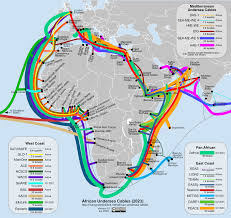 Credit Submarine Networks
Credit Submarine Networks
Transmission through light pulses
On a technical dimension undersea and terrestrial cables are composed of fiber optics and information and data are transmitted as light pulses, which in turn are rapidly emitted through glass fibers across continental telecommunications lines and then between coastal landing stations as the signals travel across the oceans. Such long-haul transmissions also require periodic signal regeneration through amplifiers embedded in the cables’ couplers to ensure signal integrity till the destination . Cables are either laid directly on the seabed or buried.A cable diameter is akin to that of a garden hose pipe at times enclosed in an integral steel wire armouring for protection in shallow waters .
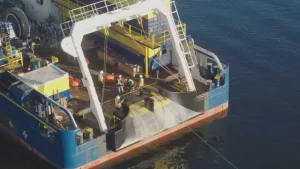 Credit Global News
Credit Global News
Jurisdictional Issues
On one side the legal aspects of undersea cables are settled however the legal regime at sea is in a grey area.The internationally recognized treaty governing submarine cables dates back to 1884 .Nowadays the legal regime is institutionalized as an integral component of the United Nations Convention on the Law of the Sea (UNCLOS). Jurisdiction and matters of maintenance of submarine cables remain uncertain generating anxiety over the geographic delimitation of ownership which is a choice between conforming to the continental shelf or exclusive economic zone boundary .
The UNCLOS clarified existing provisions to make them compatible with changes to the regime on territorial waters which now stretches to 12 nautical miles. Additionally, articles and clauses governing archipelagic waters and a nation’s EEZ were also included (article 112). UNCLOS currently represents the legal baseline providing normative governance for undersea infrastructure. Operations within the EEZ or on the continental shelf of another state may be impeded if they interfere with the rights afforded to the coastal state by other articles of UNCLOS, such as those concerning the domestic legislation in the perspective of exploitation of natural resources.
Damage to Cables
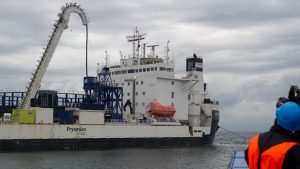 Credit Asia Financial
Credit Asia Financial
Instances have occurred when earthquakes, tsunamis, typhoons and subsea landslides damaged undersea cable networks as an earthquake in the year 2011 and the ensuing tsunami in Japan damaged half the transpacific cable network. Persistent damages are attributable to bottom trawling in commercial fishing, dredging and from oil and gas exploration.
Terrorist threats are difficult to carry out although during Egypt’s massive internet outage in 2008 three undersea cables were cut and the Egyptian Coast Guard apprehended divers in the act. Cable repair can be logistically challenging and invariably a cable repair vessel is hovering in the shallow waters. Saturation divers (SAT divers) live for up 28 days in a small topside chamber pressurized to the same level as the underwater construction environment so divers do not have to decompress after each shift. Keeping in mind the critical volume model of inert gas narcosis SAT divers can descend upto 1000 m. Marni Zabarsky was the first SAT diver.
Credit ; OilWoman Magazine
India Creeps into the China US Digital Clash
 Credit Mint
Credit Mint
In the backdrop of the US China tech war India is emerging as a hub for global underwater optic fiber cables taking advantage of the existing cable systems connecting Europe and Southeast Asia crisscrossing its coast. India dreams to be the digital equivalent of “the Saudi Arabia of oil”. India boasts at least 836 million internet subscribers , its digital economy has grown twice the rate of its economy and its 5G expansion is on its way to surmount US $1 trillion by the year 2025.
From a digitally strategic perspective Asia’s east coast is underserved . Reliance Jio Infocomm (Jio), one of India’s top telecom operators ,is constructing the largest international submarine cable system centred around India. Around 25 % of Jio has been sold to Facebook , Google and Qualcomm for almost $ 19 billion. The supplier is a world-class submarine cable supplier namely sub.com from which India has acquired two “next generation” cables spreading over 16,000 kilometers boasting a capacity of more than 200 Terabits/second.India’s undersea optic fiber network consists of 17 submarine cables terminating at 14 distinct cable landing stations . India’s environmental regulators gave the nod to Jio last year to proceed with cable laying on the sea bed.
China Reacts to US sanctions on Core Technology Sale
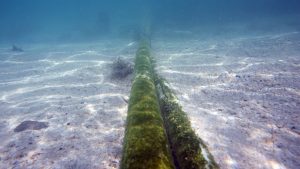
Soon after US sanctions were imposed on semiconductors sale to China and blocking China’s access to tech on account of US paranoia of espionage by China things turned sour for Chinese tech companies . Chinese companies like Huawei and China Unicom embarked upon the goal of laying thousands of kilometres of cables to challenge US, European and Japanese dominance. Google and Facebook boycotted a Chinese Peace undersea cable network designed to travel overland from China to Pakistan , a digital CPEC initiative, and then laid for 7,500 miles on the ocean bed till its destination at a landing point in France. Huawei Marine Networks is the flag bearer for China’s publicly shared goal of spanning 60 % of the global undersea optic fiber connectivity.
By Nadir Mumtaz

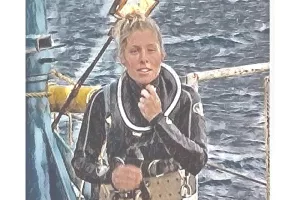
Leave A Comment